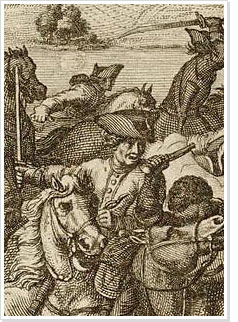Military Life > Combat and mobilization
 In the 18th century the English used to speak of 'Dutch defence' when they referred to a position that had been surrendered without any resistance. The items in the collection make it clear that the expression was undeserved.
In the 18th century the English used to speak of 'Dutch defence' when they referred to a position that had been surrendered without any resistance. The items in the collection make it clear that the expression was undeserved.
The Netherlands gained its independence in the Eighty Years' War (1568-1648), which can be followed battle by battle in a work by Willem Baudartius with illustrations by Frans Hogenberg. A colour print originating from a work published shortly after the Battle of Waterloo pictures the wounded heroic future king William II. Prints of the siege laid to Antwerp picture Dutch soldiers coming into action against their neighbours to the south during the Ten Days' Campaign (1831).
Photographs and drawings can be seen of the 1914 and 1940 mobilizations.
There are also photographs of the Dutch army in the colonies. Particularly in what is now Indonesia, the Dutch army regularly proved to be belligerent. There are photographs, drawings and maps relating to the police actions of 1947 and 1948/1949.
Go direct to:
- Afbeeldinghe ende beschrijvinghe van alle de velslagen, belegeringhen [?] geduerende d'oorloghe teghens den coningh van Spaengien (Images and descriptions of all the Battles, Sieges [?] during the war against the king of Spain) by Baudartius
- The Prince of Orange wounded at Waterloo The prints of the siege laid to Antwerp
- Hoynck van Papendrecht, sketchbook featuring soldiers interned in the period 1914-1918
- Album containing 16 postcards dating from the 1914-1918 mobilization period
- Album with 384 photographs made by Jan van Ingen during the mobilization of 1940
Look up:
